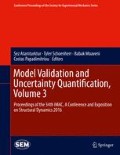Abstract
Throughout the development cycle of structural components or assemblies that require new and unproven manufacturing techniques, the issue of unit to unit variability inevitably arises. The challenge of defining dynamic similarity between units is a problem that is often overlooked or forgotten, but can be very important depending on the functional criteria of the final product. This work aims to provide some guidance on the approach to such a problem, utilizing different methodologies from the modal and vibration testing community. Expanding on previous efforts, a non-intrusive dynamic characterization test is defined to assess similarity on an assembly that is currently being developed. As the assembly is qualified through various test units, the same data sets are taken to build a database of “similarity” data. The work presented here will describe the challenges observed with defining similarity metrics on a multi-body structure with a limited quantity of test units. Also, two statistical characterizations of dynamic FRFs are presented from which one may choose criterion based on some judgment to establish whether units are in or out of family. The methods may be used when the “intended purpose” or “functional criteria” are unknown.
Sandia National Laboratories is a multi-program laboratory managed and operated by Sandia Corporation, a wholly owned subsidiary of Lockheed Martin Corporation, for the U.S. Department of Energy’s National Nuclear Security Administration under contract DE-AC04-94AL85000.The context Sandia National Laboratories is a…" has been captured as article note. Please check and confirm. Please check if the affiliations are presented correctly.
Access this chapter
Tax calculation will be finalised at checkout
Purchases are for personal use only
Abbreviations
- G T (ω):
-
Complex average of all FRF’s in data set
- i :
-
Degree of freedom
- n :
-
Total number of DOF’s
- T:
-
Individual test run
- H i (ω):
-
FRF for individual DOF
- N:
-
Total number of variability tests
- L:
-
Individual test unit
- P L (ω):
-
Complex average of all FRF’s for individual test unit L
- \( \overline{X}\left(\omega \right) \) :
-
Mean of all average FRF’s, P L (ω)
- N t :
-
Total number if test units available
- α :
-
Bounding scale factor
- \( \overline{\sigma}\left(\omega \right) \) :
-
Average standard deviation from all test units
- ECSAC:
-
Experimental Cross Signature Scale Factor
- ECSF:
-
Experimental Cross Signature Assurance Criterion
- ECSC:
-
Experimental Cross Signature Correlation value
- H :
-
Hermitian transpose
References
Allemang, R.J.: The modalPlease provide publisher and location details for all proceedings and conference type of references. assurance criterion—twenty years of use and abuse. Sound Vib. Mag., August, 14–20 (2003)
Pascual, R., Golinval, J., Razeto, M.: A frequency domain correlation technique for model correlation and updating. In: Proceedings of the 15th International Modal Analysis Conference, pp. 587–592 (1997)
Heylen, W., Avitabile, P.: Correlation considerations—part 5 (degree of freedom correlation techniques). In: Proceedings of the 16th International Modal Analysis Conference, pp. 207–214 (1998)
Fotsch, D., Ewins, D.J.: Applications of MAC in the frequency domain. In: Proceedings of the 18th International Modal Analysis Conference, pp. 1225–1231 (2000)
Dascotte, E., Strobbe, J.: Updating finite element models using FRF correlation functions. In: Proceedings of the 17th International Modal Analysis Conference (1999)
Moya, A., Marinone, T.: Comparison of FRF correlation techniques. In: Proceedings of the 33rd International Modal Analysis Conference (2014)
Author information
Authors and Affiliations
Corresponding author
Editor information
Editors and Affiliations
Rights and permissions
Copyright information
© 2016 The Society for Experimental Mechanics, Inc.
About this paper
Cite this paper
Moya, A.C., Harvie, J.M., Starr, M.J. (2016). The Challenge of Dynamic Similarity Assessment. In: Atamturktur, S., Schoenherr, T., Moaveni, B., Papadimitriou, C. (eds) Model Validation and Uncertainty Quantification, Volume 3. Conference Proceedings of the Society for Experimental Mechanics Series. Springer, Cham. https://doi.org/10.1007/978-3-319-29754-5_23
Download citation
DOI: https://doi.org/10.1007/978-3-319-29754-5_23
Published:
Publisher Name: Springer, Cham
Print ISBN: 978-3-319-29753-8
Online ISBN: 978-3-319-29754-5
eBook Packages: EngineeringEngineering (R0)

